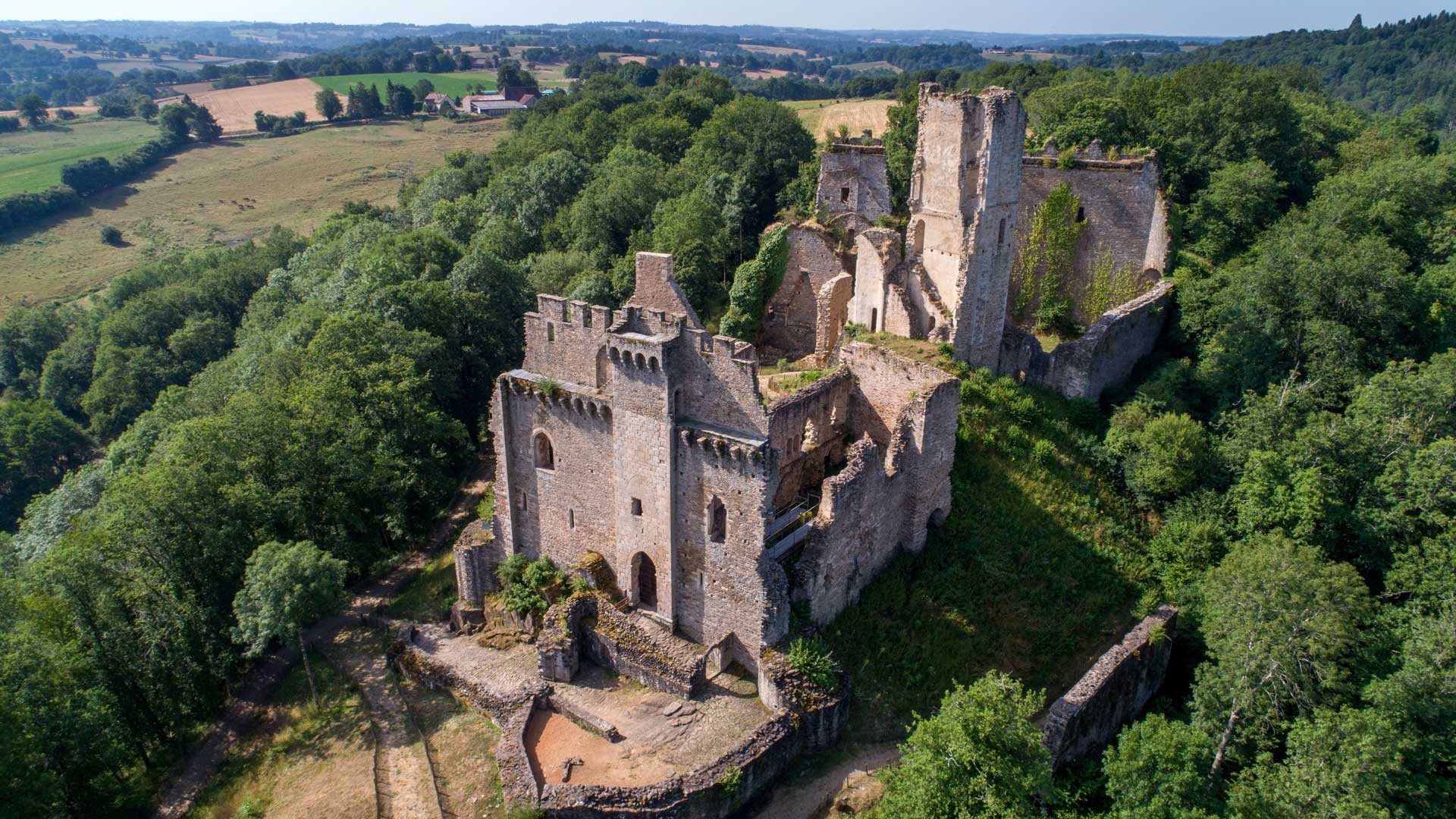KEY DATES IN CHÂLUCET’S HISTORY
Two castles, a multi-faceted history: a village and community of knights, then a palace belonging to the ambitious Géraud de Maulmont in the 13th century, a brigands’ lair in the 14th century and an imposing ruin since the end of the 16th century, Châlucet’s history is both vibrant and varied.
Let’s take a look at some of the key dates over the centuries.
1130 The origins of the castrum (12th century)
The château de Châlucet (upper and lower) was founded in around 1130 by two knights from the Jaunhac family, suzerains to the Viscount of Limoges, Gui VI. At this time, the castrum was managed by several knights (between 20 and 30 families), who were its joint lords. In exchange for their military protection, they received a house, garden and an income paid by the villagers in the surrounding area.
A full-scale village developed around the Tower of Jeannette, the keep in the lower castrum. We also know that there were outlying districts, gardens, orchards and possibly even vineyards.
Today no visible remains can be seen of the upper castle. It is believed that a keep and accommodation for the lord once stood there.
1250-1270 In the shadow of Gui VI, the rise of Géraud de Maulmont
The Viscount of Limoges, Gui VI, succeeded in obtaining part of the suzerainty over Châlucet. He died in 1263, after having married Marguerite, the daughter of the powerful Duke of Burgundy in 1258. His right-hand man, Géraud de Maulmont, became his widow’s main adviser. She gave him free rein to manage her affairs as he saw fit.
1250-1270 In the shadow of Gui VI, the rise of Géraud de Maulmont
The Viscount of Limoges, Gui VI, succeeded in obtaining part of the suzerainty over Châlucet. He died in 1263, after having married Marguerite, the daughter of the powerful Duke of Burgundy in 1258. His right-hand man, Géraud de Maulmont, became his widow’s main adviser. She gave him free rein to manage her affairs as he saw fit.
1260-1277 “The Viscount’s War”
The Viscount’s War started in Limousin in 1262. On one side there was Limoges and its Limougeauds, who claimed that their city did not belong to the Viscount of Limoges. On the other side, there was the Viscount himself who claimed that the city did indeed belong to him. Châlucet’s strategic position made it ideal for controlling Limoges and the roads leading there. The castle became the centre of operations carried out against the inhabitants of Limoges during the ensuing Viscount’s War. Gui VI, and then Viscountess Marguerite, had the support of the King of France, whilst the inhabitants of Limoges were supported by the Plantagenets who ruled over all of Aquitaine at that time.
13th century Géraud de Maulmont’s fortress
After putting up stiff resistance and seeking the involvement of their protector, the King of England, the inhabitants of Limoges finally surrendered the keys to their city to Viscountess Marguerite. She in turn left her rights to Châlucet to Géraud de Maulmont as a reward.
He proceeded to build a genuine fortified palace on the site of the original upper castle: barbican, a guards’ walkway, machicolations, a portcullis and casements were included in the design as defence features.
Round towers were built at each corner of the castle. This was a unique monument in the late 13th century, designed to express the power of its lord and master.
13th century Géraud de Maulmont’s fortress
After putting up stiff resistance and seeking the involvement of their protector, the King of England, the inhabitants of Limoges finally surrendered the keys to their city to Viscountess Marguerite. She in turn left her rights to Châlucet to Géraud de Maulmont as a reward.
He proceeded to build a genuine fortified palace on the site of the original upper castle: barbican, a guards’ walkway, machicolations, a portcullis and casements were included in the design as defence features.
Round towers were built at each corner of the castle. This was a unique monument in the late 13th century, designed to express the power of its lord and master.
13th – 14th century An inhabited fortress
Géraud de Maulmont died in 1299 and the castle was left to one of his heirs.
In 1305, the King of France Philippe IV (known as Philippe le Bel) came into possession of the fortress in the Limousin region. He never once set food there and appointed squires to manage maintenance and day-to-day affairs.
In 1317, his successor King Philippe V gave Châlucet to his trusty adviser, Henri de Sully. Henri de Sully also chose not to live at Châlucet and the Sully family made very few changes to the castle.
Late 14th century A brigands’ lair
During the unrest of the Hundred Years’ War, independent warlords, known as routiers, seized control of several castles in this centrally-located region, where the authority of both the King of France and the King of England (who was also still the Duke of Aquitaine) had little influence. Châlucet and its fine southern curtain wall fell into the hands of one of the most powerful routiers, Perrot le Béarnais, who made it one of his lairs.
After Le Béarnais’ departure, the Sully family gave the castle to Charles d’Albray. He also appointed squires to manage affairs at Châlucet. These squires frequently abused their powers and behaved in very much the same way as the routiers. Consequently Châlucet was poorly maintained and fell into disrepair and eventually ruin.
Late 14th century A brigands’ lair
During the unrest of the Hundred Years’ War, independent warlords, known as routiers, seized control of several castles in this centrally-located region, where the authority of both the King of France and the King of England (who was also still the Duke of Aquitaine) had little influence. Châlucet and its fine southern curtain wall fell into the hands of one of the most powerful routiers, Perrot le Béarnais, who made it one of his lairs.
After Le Béarnais’ departure, the Sully family gave the castle to Charles d’Albray. He also appointed squires to manage affairs at Châlucet. These squires frequently abused their powers and behaved in very much the same way as the routiers. Consequently Châlucet was poorly maintained and fell into disrepair and eventually ruin.
16th century Châlucet demolished
Géraud de Maulmont, and then Perrot le Béarnais, had terrorised the Limougeauds. The Limougeauds, who could perhaps still remember the Viscount’s War and the Hundred Year’s War, wanted to be permanently rid of the threat that this nearby castle presented. In 1594, at the end of the Wars of Religion, they obtained permission to demolish Châlucet…
100 workers were sent out to demolish the fortress and in just four days Châlucet was reduced to ruins.



